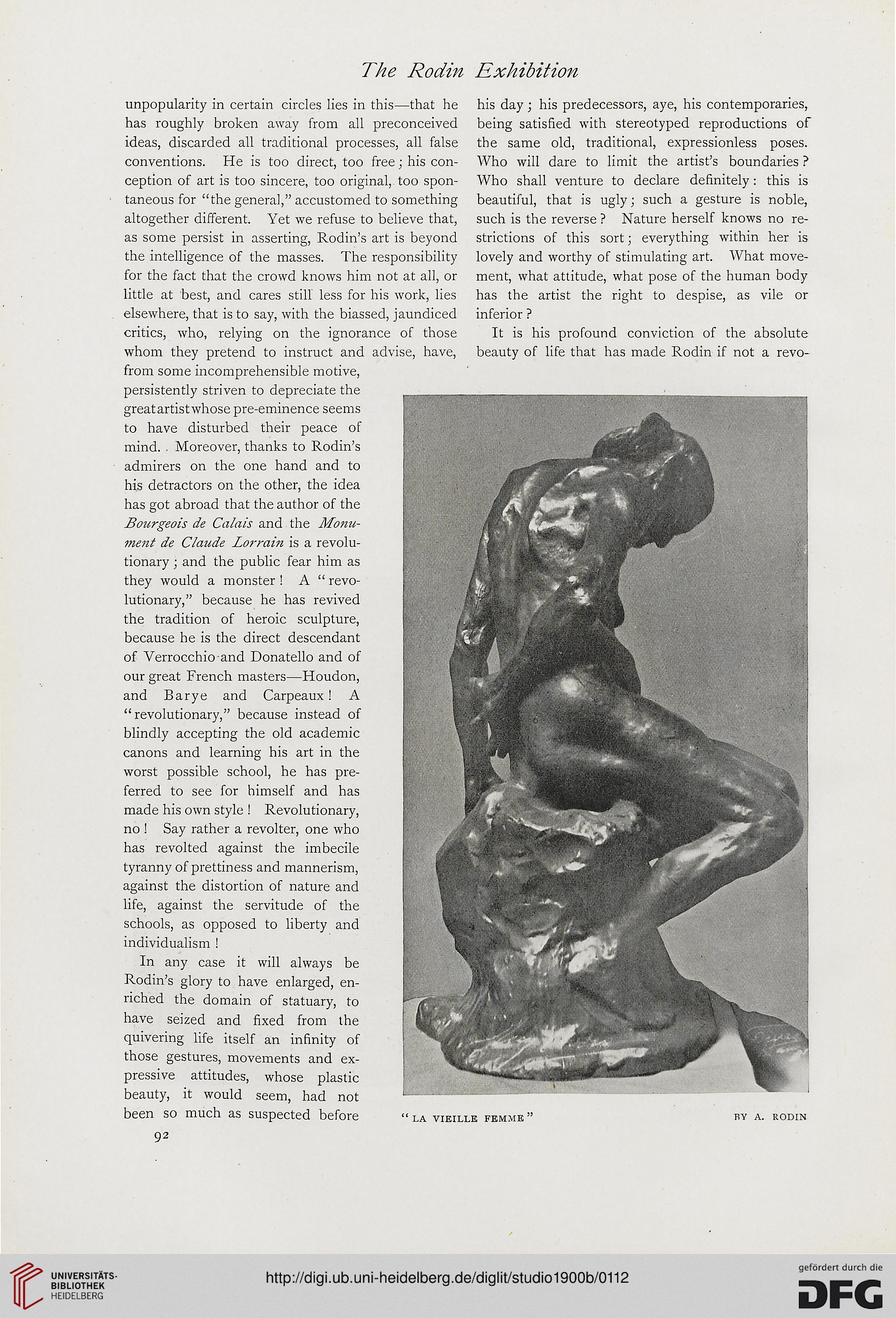The Rodin Exhibition
unpopularity in certain circles lies in this—that he his day; his predecessors, aye, his contemporaries,
has roughly broken away from all preconceived being satisfied with stereotyped reproductions of
ideas, discarded all traditional processes, all false the same old, traditional, expressionless poses,
conventions. He is too direct, too free; his con- Who will dare to limit the artist's boundaries ?
ception of art is too sincere, too original,, too spon- Who shall venture to declare definitely: this is
taneous for "the general," accustomed to something beautiful, that is ugly ; such a gesture is noble,
altogether different. Yet we refuse to believe that, such is the reverse ? Nature herself knows no re-
as some persist in asserting, Rodin's art is beyond strictions of this sort; everything within her is
the intelligence of the masses. The responsibility lovely and worthy of stimulating art. What move-
for the fact that the crowd knows him not at all, or ment, what attitude, what pose of the human body
little at best, and cares still less for his work, lies has the artist the right to despise, as vile or
elsewhere, that is to say, with the biassed, jaundiced inferior ?
critics, who, relying on the ignorance of those It is his profound conviction of the absolute
whom they pretend to instruct and advise, have, beauty of life that has made Rodin if not a revo-
from some incomprehensible motive,
persistently striven to depreciate the
great artist whose pre-eminence seems
to have disturbed their peace of
mind. . Moreover, thanks to Rodin's
admirers on the one hand and to
his detractors on the other, the idea
has got abroad that the author of the
Borirgeois de Calais and the Monu-
ment de Claude Lo?-rain is a revolu-
tionary ; and the public fear him as
they would a monster ! A " revo-
lutionary," because he has revived
the tradition of heroic sculpture,
because he is the direct descendant
of Verrocchio and Donatello and of
our great French masters—Houdon,
and Barye and Carpeaux ! A
"revolutionary," because instead of
blindly accepting the old academic
canons and learning his art in the
worst possible school, he has pre-
ferred to see for himself and has
made his own style ! Revolutionary,
no ! Say rather a revolter, one who
has revolted against the imbecile
tyranny of prettiness and mannerism,
against the distortion of nature and
life, against the servitude of the
schools, as opposed to liberty and
individualism !
In any case it will always be
Rodin's glory to have enlarged, en-
riched tire domain of statuary, to
have seized and fixed from the
quivering life itself an infinity of
those gestures, movements and ex-
pressive attitudes, whose plastic
beauty, it would seem, had not
been so much as suspected before « la vieille femme " by a. rodin
92
unpopularity in certain circles lies in this—that he his day; his predecessors, aye, his contemporaries,
has roughly broken away from all preconceived being satisfied with stereotyped reproductions of
ideas, discarded all traditional processes, all false the same old, traditional, expressionless poses,
conventions. He is too direct, too free; his con- Who will dare to limit the artist's boundaries ?
ception of art is too sincere, too original,, too spon- Who shall venture to declare definitely: this is
taneous for "the general," accustomed to something beautiful, that is ugly ; such a gesture is noble,
altogether different. Yet we refuse to believe that, such is the reverse ? Nature herself knows no re-
as some persist in asserting, Rodin's art is beyond strictions of this sort; everything within her is
the intelligence of the masses. The responsibility lovely and worthy of stimulating art. What move-
for the fact that the crowd knows him not at all, or ment, what attitude, what pose of the human body
little at best, and cares still less for his work, lies has the artist the right to despise, as vile or
elsewhere, that is to say, with the biassed, jaundiced inferior ?
critics, who, relying on the ignorance of those It is his profound conviction of the absolute
whom they pretend to instruct and advise, have, beauty of life that has made Rodin if not a revo-
from some incomprehensible motive,
persistently striven to depreciate the
great artist whose pre-eminence seems
to have disturbed their peace of
mind. . Moreover, thanks to Rodin's
admirers on the one hand and to
his detractors on the other, the idea
has got abroad that the author of the
Borirgeois de Calais and the Monu-
ment de Claude Lo?-rain is a revolu-
tionary ; and the public fear him as
they would a monster ! A " revo-
lutionary," because he has revived
the tradition of heroic sculpture,
because he is the direct descendant
of Verrocchio and Donatello and of
our great French masters—Houdon,
and Barye and Carpeaux ! A
"revolutionary," because instead of
blindly accepting the old academic
canons and learning his art in the
worst possible school, he has pre-
ferred to see for himself and has
made his own style ! Revolutionary,
no ! Say rather a revolter, one who
has revolted against the imbecile
tyranny of prettiness and mannerism,
against the distortion of nature and
life, against the servitude of the
schools, as opposed to liberty and
individualism !
In any case it will always be
Rodin's glory to have enlarged, en-
riched tire domain of statuary, to
have seized and fixed from the
quivering life itself an infinity of
those gestures, movements and ex-
pressive attitudes, whose plastic
beauty, it would seem, had not
been so much as suspected before « la vieille femme " by a. rodin
92




